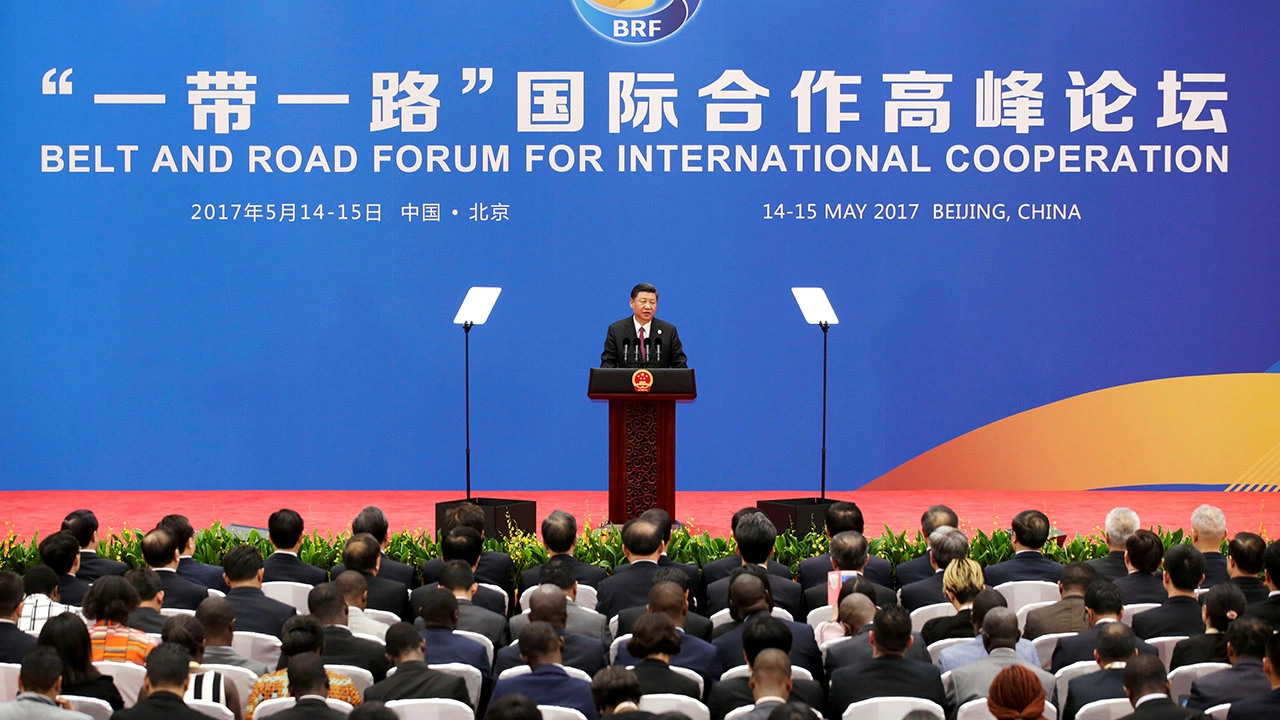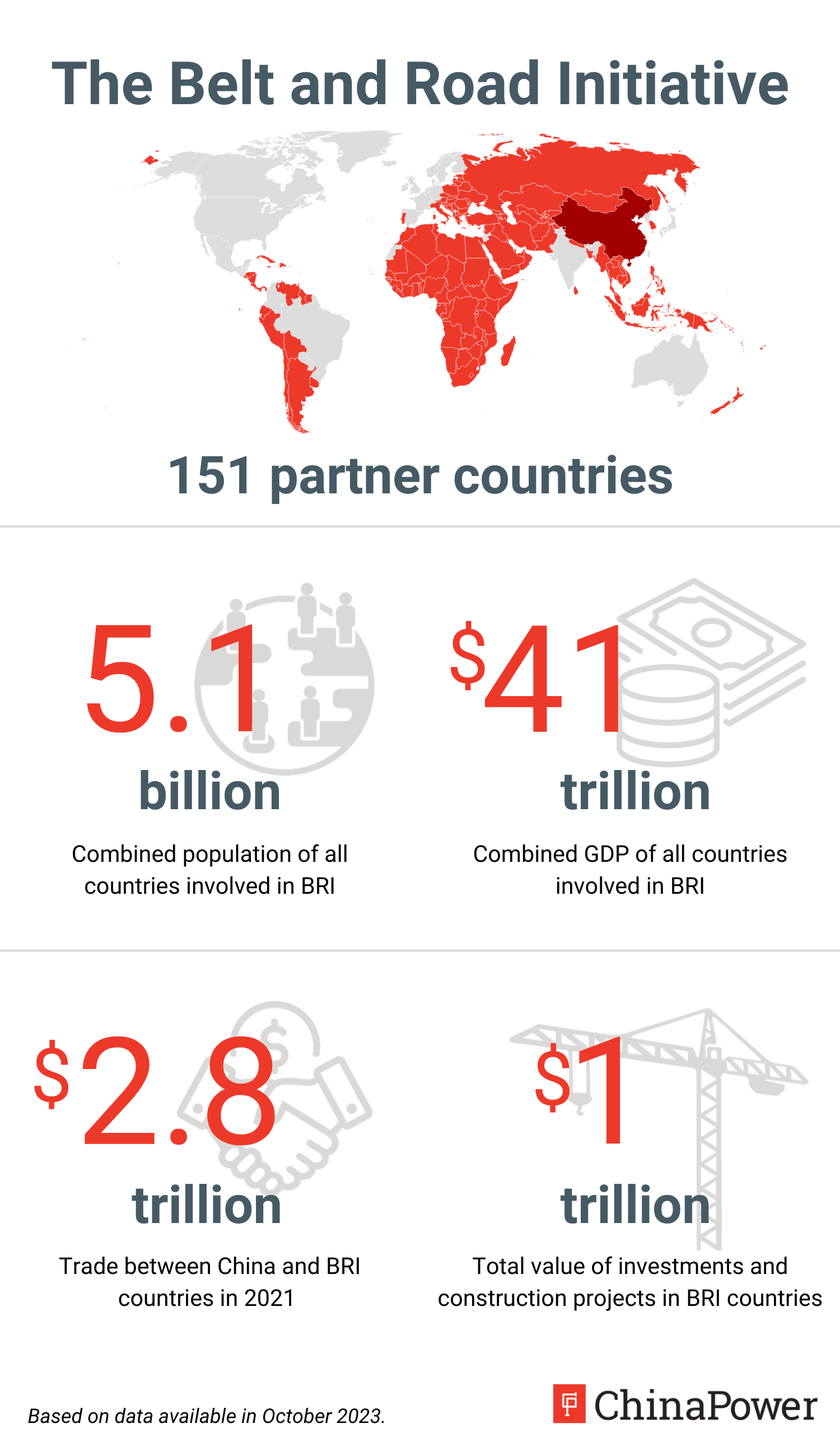Below is a comprehensive analysis of China’s Belt and Road Initiative (BRI), addressing its inception, spending, expansion, geographic reach, financing terms, accusations of colonialism, security implications, positives, parallels to the Marshall Plan, soft power gains, and the potential for a US-EU-India counter-strategy, including a proposed $10 trillion fund to rival the BRI.
- $800 billion in loans and investments from 2013 to 2022, primarily for infrastructure, energy, and mining projects.
- $240 billion in bailouts for debt-distressed BRI countries since 2019, reflecting financial challenges faced by borrowers.
- Spending has slowed since the COVID-19 pandemic due to China’s economic slowdown, reduced global demand, and debt distress in recipient countries. In 2020, Chinese loans to Africa dropped 77% from $8.2 billion to $1.9 billion.
- Digital Silk Road: Investments in telecommunications, 5G networks, fiber optic cables, and China’s BeiDou satellite navigation system as alternatives to Western technologies like GPS.
- Health Silk Road: Post-COVID initiatives targeting healthcare infrastructure and vaccine diplomacy.
- Green Silk Road: A shift toward sustainable projects, with China pledging in 2019 to stop financing coal-fired power plants abroad.
- Polar Silk Road: Investments in Arctic infrastructure to access new trade routes.
- Space Silk Road: Satellite and space technology cooperation.
- Asia: Major projects like the China-Pakistan Economic Corridor (CPEC) ($60 billion+), Laos-China Railway, and ports in Sri Lanka (Hambantota) and Pakistan (Gwadar).
- Africa: Infrastructure investments, such as the Addis Ababa–Djibouti Railway, Maputo–Katembe Bridge in Mozambique, and energy projects, with China financing ~20% of African infrastructure.
- Europe: Investments in ports (e.g., Piraeus in Greece) and rail links to connect China to European markets.
- Middle East: Projects like Egypt’s Suez Canal developments and Saudi Arabia’s infrastructure.
- Latin America and Oceania: Emerging focus, with projects like ports in Panama and energy infrastructure in Argentina.
- Loan Structure: Loans are often near market interest rates (around 6%), higher than those from multilateral institutions like the World Bank or IMF, which offer concessional rates.
- Collateral Requirements: Contracts may include clauses requiring collateral, such as infrastructure assets, or giving China the right to demand repayment at any time. Some contracts restrict restructuring with the Paris Club, limiting debtor flexibility.
- Opacity: Loan terms are often non-transparent, complicating debt sustainability assessments for recipient countries.
- Debt Restructuring: China has restructured loans for countries like Pakistan and Sri Lanka, extending repayment periods or lowering interest rates, but rarely cancels debt outright due to domestic political constraints.
- Sri Lanka Case: In 2017, Sri Lanka leased the Hambantota Port to a Chinese SOE for 99 years for $1.12 billion to alleviate debt distress. However, the debt was largely unrelated to the port, stemming from Western-dominated capital markets and poor domestic policies. China did not seize the port; the lease was a negotiated deal to bolster Sri Lanka’s foreign reserves.
- Other Examples: Countries like the Maldives ($1.3 billion in Chinese debt, ~25% of GDP), Pakistan ($30 billion via CPEC), and Djibouti face debt burdens, but no clear evidence shows China deliberately engineers defaults to seize assets.
- Counterarguments: Studies, such as those by the Center for Global Development, suggest China’s lending (2% of developing countries’ $6.9 trillion debt from 2000–2016) is not the primary cause of debt distress, which often stems from Western colonial legacies or domestic mismanagement. Debt-trap accusations are debated, with some arguing they are exaggerated by Western narratives to counter China’s influence.
- Criticisms: Opaque loan terms, environmental damage, and reliance on Chinese labor and materials have sparked local backlash in countries like Pakistan and Sri Lanka, fueling perceptions of exploitation. Clauses allowing China to influence debtor policies (e.g., on Taiwan) raise sovereignty concerns.
- Sri Lanka: The 2014 docking of a Chinese submarine at Colombo port raised concerns about China’s military presence in the Indian Ocean, challenging India’s naval dominance. The Hambantota Port’s strategic location fuels speculation about dual-use (commercial-military) potential, though Sri Lanka insists it is for civilian use.
- India’s Concerns: India views the BRI, particularly CPEC (which passes through disputed Kashmir territory), as a strategic encirclement (“String of Pearls”) to counter its regional influence. Ports like Gwadar (Pakistan) and Hambantota enhance China’s naval reach, posing security risks.
- Djibouti: China’s military base, established in 2017, is officially a logistics facility but includes military infrastructure, raising concerns about China’s global military projection.
- Infrastructure Development: The BRI has filled a global infrastructure financing gap, estimated at $57 trillion from 2013–2030. Projects like the Addis Ababa–Djibouti Railway and Maputo–Katembe Bridge have improved trade and connectivity in Africa.
- Economic Growth: In countries like Ethiopia and Uganda, Chinese-funded industrial parks have boosted production and job creation, albeit often low-skilled.
- Trade Expansion: The BRI has opened new markets for Chinese goods and integrated developing economies into global trade networks, reducing trade barriers.
- Energy Access: Energy projects, including hydropower and solar, have increased electricity access in Africa and Asia, supporting industrial growth.
- Global South Empowerment: The BRI has given developing countries alternatives to Western-dominated financing (e.g., IMF, World Bank), which often come with stringent conditions.
- Similarities:
- Geopolitical Goals: Like the Marshall Plan, which countered Soviet influence, the BRI enhances China’s geopolitical clout and counters U.S.-led global order.
- Economic Reconstruction: Both initiatives fund infrastructure to spur economic growth and integrate recipient countries into the financier’s economic orbit.
- Soft Power: The Marshall Plan bolstered U.S. leadership; the BRI enhances China’s image as a global development partner, particularly in the Global South.
- Differences:
- Scale and Scope: The BRI’s $1 trillion+ investment dwarfs the Marshall Plan’s scope, spanning 150+ countries versus 16 in Europe.
- Financing Model: The Marshall Plan offered grants with minimal conditions; the BRI uses loans with market-rate interest, leading to debt sustainability issues.
- Intent: The Marshall Plan was explicitly anti-communist; the BRI is framed as a “win-win” but serves China’s strategic interests, including yuan internationalization and resource security.
- Positioning China as a Global Leader: The initiative portrays China as a benevolent partner, challenging the U.S.-led international order. High-level participation in BRI forums (e.g., 29 heads of state in 2017) enhances China’s diplomatic clout.
- Global South Alignment: In Africa and Latin America, China is perceived as a more influential economic actor than the U.S., driven by BRI infrastructure investments.
- Diplomatic Leverage: BRI participation has influenced countries like Cambodia and Laos to align with China on issues like the South China Sea and Taiwan’s diplomatic isolation.
- Cultural and Economic Ties: The BRI promotes people-to-people exchanges and trade, strengthening China’s image as a global connector.
- U.S. Initiatives:
- Build Back Better World (B3W): Launched by the G7 in 2021, it aims to mobilize $600 billion by 2027 ($200 billion from the U.S.) for infrastructure in developing countries, focusing on private investment rather than direct loans.
- Blue Dot Network: A U.S.-Japan-Australia initiative to certify sustainable infrastructure projects, but it lacks direct financing.
- Development Finance Corporation (DFC): Offers $60 billion for infrastructure, but its scale is dwarfed by China’s lending.
- EU’s Global Gateway: Launched in 2021, it aims to mobilize €300 billion ($330 billion) by 2027 for sustainable infrastructure, focusing on private investment and green development. It avoids direct loans, limiting its appeal to debt-strapped nations.
- India’s Efforts: India opposes the BRI, particularly CPEC, due to sovereignty concerns over disputed territories. It promotes alternatives like the India-Middle East-Europe Economic Corridor (IMEC), announced at the 2023 G20, to connect India to Europe via the Middle East. India also leverages the Quadrilateral Security Dialogue (Quad) with the U.S., Japan, and Australia to counter China’s influence.
- Financing Gap: Western initiatives rely on private investment, which is risk-averse, while China offers direct, state-backed loans.
- Scale: Combined, B3W and Global Gateway are far smaller than the BRI’s $1 trillion+.
- Coordination: Aligning U.S., EU, and Indian priorities is complex due to differing strategic goals and domestic constraints.
- Filling the Infrastructure Gap: The Global South faces a $57 trillion infrastructure need by 2030. A $5 trillion U.S.-led fund could address critical needs in drinking water, sanitation, sewage, schools, hospitals, 5G/6G, satellite internet, roads, bridges, trains, ports, airports, and electricity, fostering economic growth and stability.
- Geopolitical Leverage: Matching or exceeding China’s BRI would position the U.S. as a leader in global development, countering China’s influence and strengthening alliances in the Global South.
- Reasonable Terms: Offering loans at 6% interest (comparable to BRI rates but with transparent terms) could attract countries wary of China’s opaque lending while ensuring sustainability.
- Economic Benefits: U.S. and allied firms could secure contracts, boosting domestic economies and creating jobs, similar to China’s use of SOEs in the BRI.
- Debt Burden: A $5 trillion debt would strain U.S. finances, especially with a national debt already exceeding $33 trillion (2025). It risks domestic backlash and fiscal instability.
- Implementation Challenges: The U.S. lacks China’s centralized control over financing and project execution, complicating large-scale infrastructure deployment.
- Risk of Failure: Projects in developing countries face corruption, political instability, and economic viability risks, potentially leading to losses or reputational damage.
- Competition with Allies: Coordinating with the EU and India could lead to conflicts over project allocation and strategic priorities.
- Outscale the BRI: A $10 trillion fund would surpass the BRI’s estimated $1–8 trillion, signaling unmatched commitment to global development. It could cover critical infrastructure (water, sanitation, schools, hospitals, 5G/6G, satellite internet, transport, energy) across the Global South, addressing urgent needs and fostering long-term growth.
- Transparent Financing: Unlike the BRI’s opaque terms, a U.S.-EU fund could offer concessional loans (e.g., 2–4% interest) and grants, adhering to Paris Club standards, reducing debt distress risks, and appealing to countries wary of China’s lending.
- Geopolitical Counterweight: The fund would counter China’s influence, strengthen democratic norms, and align the Global South with Western values, preventing strategic encirclement (e.g., China’s “String of Pearls” around India).
- Soft Power Boost: By prioritizing sustainable, community-focused projects (e.g., clean water, education), the U.S. and EU could enhance their global image, outpacing China’s soft power gains.
- Economic Returns: Contracts for U.S. and EU firms would stimulate economies, while improved infrastructure would boost global trade, benefiting all parties.
- Funding Structure: The U.S. could contribute $5 trillion, the EU $4 trillion, and other allies (e.g., Japan, India, Australia) $1 trillion, spread over 20–30 years. Multilateral institutions like the World Bank could co-finance to reduce risk.
- Focus Areas: Prioritize high-impact sectors: clean water, sanitation, renewable energy, digital connectivity (5G/6G, satellite internet), and transport (roads, bridges, ports, airports). Projects should align with local needs and include capacity-building for governance and maintenance.
- Transparency and Standards: Adhere to international standards for environmental, labor, and financial sustainability, distinguishing the fund from the BRI’s criticized practices.
- Partnerships: Engage India to counter China in South Asia, leveraging its regional influence and initiatives like IMEC. Include Japan and Australia for Indo-Pacific projects, enhancing Quad cooperation.
- Fiscal Constraints: The U.S. and EU face domestic debt concerns, making a $10 trillion commitment politically contentious.
- Coordination: Aligning priorities among diverse partners (U.S., EU, India, etc.) requires overcoming bureaucratic and geopolitical hurdles.
- Risk Management: Developing countries’ political instability, corruption, and economic challenges could lead to project failures or defaults, necessitating robust risk assessment.
- China’s Response: Beijing could escalate BRI investments or offer competing terms, intensifying geoeconomic rivalry.





